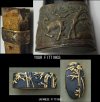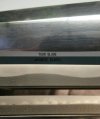I make nothing of the characters. They may be jibberish, but may have some Chinese meaning ??
No idea what they may do with the wood.
It is not the difference between folded and an imitation. your blade looks to be folded steel, just not a Japanese sword. More like pattern welded damascus, which is folded.
Part of knowing how to distinguish real Japanese swords from Chinese knock offs is experience. Having owned or in my possession, as well as the opportunity to study, literally hundreds of genuine Japanese swords over the last 25 years a quick glance is enough, or a description like yours, which immediately gave me a gut feeling.
Everything in your photos scream Chinese knock off. The fittings are pitiful, the blade has no hamon and doesn't begin to look genuine.
The key is for you to learn to differentiate is in looking at as many genuine Japanese swords as possible ie; books, shows, online etc.. Find a sword group in your area and try to attend some meetings.
You mention wanting to buy a genuine Japanese sword. Before you do you should buy some books and study for a while. At the very least be sure to seek out a competent and honest dealer to help you. At the beginner level avoid e-bay like the plague. There are a few descent dealers on e-bay but as a novice it is hard to know the difference. For every descent dealer on e-bay there are many, many crooks. There are several who are straight up thieves, offering items which do not belong to them.
You should know that collecting Japanese swords is a very expensive hobby, and like most things you get what you pay for. before making a first purchase, I would recommend saving your money until you have a bare minimum budget of $3000. Yes, you can find swords for cheaper, but cheap equals lower quality/condition.
Look at some of the swords which are the subject of inquiry's on this forum. Most are rusted, tarnished, etc., beyond the point of ever learning anything from it. I understand that sometimes people find stuff or inherit stuff, and that is different in regards to wanting to know a little something about it. But only so much can obtained from a piece in poor condition.
If you want to study the Japanese sword it must be in good enough polish for you to see the activity in the steel. When you consider that a professional Japanese polish alone runs in the neighborhood of $100 per inch of cutting edge, it doesn't take a brain surgeon to figure out why these swords can be so expensive.
And again, a sword in poor polish will teach you nothing. Like trying to read a book whose pages have been painted black.
Here are a couple of examples for you to compare.
View attachment 430882
View attachment 430883















